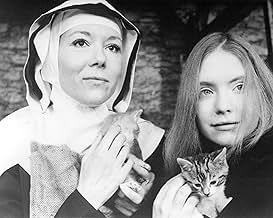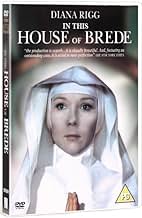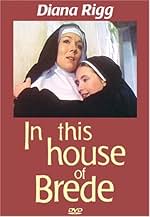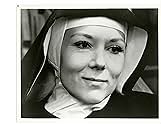अपनी भाषा में प्लॉट जोड़ेंA well-to-do London businesswoman gives up her comfortable life, including the man who loves her, to become a cloistered Benedictine nun.A well-to-do London businesswoman gives up her comfortable life, including the man who loves her, to become a cloistered Benedictine nun.A well-to-do London businesswoman gives up her comfortable life, including the man who loves her, to become a cloistered Benedictine nun.
- 1 प्राइमटाइम एमी के लिए नामांकित
- कुल 1 नामांकन
Fanny Rowe
- Miss Bowman
- (as Frances Rowe)
Dearbhla Molloy
- Dame Beatrice
- (as Dervla Molloy)
Yasuko Nagazumi
- Mariko
- (as Yasuko Magazumi)
फ़ीचर्ड समीक्षाएं
I certainly can appreciate the previous review by the person who very capably compares the book to the movie. But I had not read the book when I first saw the movie years ago on the late show, and I still have not read it. What I have done is stop to watch the movie again and again every time I see that it is coming on. Freed from comparison, the movie is lovely. I have never felt the movie gives a good enough sense of the depth of emotion it seems (to me, at least) would be necessary to impel the main character to make the decision she makes to enter the convent; nonetheless, once the viewer accepts the fact of that decision, the rest of the movie is delightful. Rigg plays her role with clarity, thoughtfulness, circumspection, and elegance. The slow resolution of conflict within the cloistered community is gracefully marked. It is a masterful illustration of patience as virtue. The movie always leaves me with a sense of peace and, finally, joy, although I am not a religious person in the least. I recommend it highly.
If I had never read the novel (and loved it), and if I had never lived the cloistered religious life (which I have), I would recommend this film without reserve.
My reservations are based on the following: Having lived in a cloister for over two years, I can tell you that, even in these post-Vatican II times, a postulant or novice would never be permitted to speak freely with another sister, especially an elder, without permission from her novice mistress. Recreations are not "free time", as depicted in the film; it is a daily get-together of the community as a whole, and it is encouraged that you converse in groups of at least three (you can talk to one other sister if you feel you have to, but certainly not for the whole recreation period). Also, silence being an essential and necessary aspect of contemplative monasticism, a sister, no matter what rank, would not sing out loud whenever and wherever she felt moved to do so, and especially not during work time. I could go on... but suffice it to say that this film is not an accurate depiction of cloistered life.
However, I do have positive feelings about this film. Even though it bears little resemblance in plot to the novel, it's still a good basic story in itself and is very well acted by an ensemble of wonderful actors. And, inaccurate of the life as it is, the film still evokes in me a nostalgic longing for the monastery, and I admit that I watch it for mainly that reason.
Oh, that the BBC would produce a mini-series of Godden's wonderful novel! That would be something to see. Godden was herself a Benedictine Oblate (lay persons connected by vows to a religious order), and her book is a loving and faithful tribute to Benedictine nuns everywhere.
My reservations are based on the following: Having lived in a cloister for over two years, I can tell you that, even in these post-Vatican II times, a postulant or novice would never be permitted to speak freely with another sister, especially an elder, without permission from her novice mistress. Recreations are not "free time", as depicted in the film; it is a daily get-together of the community as a whole, and it is encouraged that you converse in groups of at least three (you can talk to one other sister if you feel you have to, but certainly not for the whole recreation period). Also, silence being an essential and necessary aspect of contemplative monasticism, a sister, no matter what rank, would not sing out loud whenever and wherever she felt moved to do so, and especially not during work time. I could go on... but suffice it to say that this film is not an accurate depiction of cloistered life.
However, I do have positive feelings about this film. Even though it bears little resemblance in plot to the novel, it's still a good basic story in itself and is very well acted by an ensemble of wonderful actors. And, inaccurate of the life as it is, the film still evokes in me a nostalgic longing for the monastery, and I admit that I watch it for mainly that reason.
Oh, that the BBC would produce a mini-series of Godden's wonderful novel! That would be something to see. Godden was herself a Benedictine Oblate (lay persons connected by vows to a religious order), and her book is a loving and faithful tribute to Benedictine nuns everywhere.
Diana Rigg made a peerlessly suave secret agent. For the 60's British TV series "The Avengers," she never won a single Emmy (They always went to Martin Landau's wife-at-the-time Barbara Bain for "Mission Impossible.), but there was no one who matched the simmering confidence and shimmering elegance of Mrs. Emma Peel. No matter what the challenge put before her, Rigg remained unshaken.
"In This House of Brede" posed a much different challenge than the ones to which Rigg was accustomed: doffing the miniskirts and knee-length boots and playing a woman who had lost both husband and daughter and decides to leave her successes in the workplace for life as a Benedictine nun. Her Dame Philippa is well-schooled (She already knows Latin before entering the convent.); experienced in the business world (So she intimidates Dame Agnes (Pamela Brown), one of the senior nuns who feels her advanced age poses a serious problem at being settled in the cloister.), and very determined (although she has barely recovered from the loss of her daughter in a car accident). The superior of Brede who encouraged Philippa to consider religious life dies as she enters the postulancy. She's lucky, however, that the congregation has the good sense to elect a kind, fair-minded woman (Gwen Watford) to lead them, and help Philippa through the most trying times of her novitiate. It's the challenge to form a loving, but disinterested life at Brede that threatens to capsize Philippa's hard-earned equanimity, when a beautiful, young prospect (Judy Bowker who was equally as captivating in "The Shooting Party") arrives. Memories of her daughter well up to recall feelings she thought she had put behind her years ago.
It's easy to become impatient with this movie's prudence; the in-fighting and petulance among the nuns are dispelled without much fuss. "In This House of Brede" never makes much of these women's triumphs. To find any dramatic tension, you need to look to Rigg's pale, drawn face or Brown's wide, but tired and stricken eyes. Yet the combination of this even mindedness and struggle is simultaneously calming and tonic. The gaggle of giggling novices Dame Philippa ushers back to their native Japan bring a sense of renewed hope to the order. Even Dame Agnes with her rankled nerves, and hurt feelings, and petty jealousies finds peace in the end. It gives the rest of us cause for celebration: that, with God's help, any of us can conquer ourselves--and, we hope, as these women do--elegantly.
"In This House of Brede" posed a much different challenge than the ones to which Rigg was accustomed: doffing the miniskirts and knee-length boots and playing a woman who had lost both husband and daughter and decides to leave her successes in the workplace for life as a Benedictine nun. Her Dame Philippa is well-schooled (She already knows Latin before entering the convent.); experienced in the business world (So she intimidates Dame Agnes (Pamela Brown), one of the senior nuns who feels her advanced age poses a serious problem at being settled in the cloister.), and very determined (although she has barely recovered from the loss of her daughter in a car accident). The superior of Brede who encouraged Philippa to consider religious life dies as she enters the postulancy. She's lucky, however, that the congregation has the good sense to elect a kind, fair-minded woman (Gwen Watford) to lead them, and help Philippa through the most trying times of her novitiate. It's the challenge to form a loving, but disinterested life at Brede that threatens to capsize Philippa's hard-earned equanimity, when a beautiful, young prospect (Judy Bowker who was equally as captivating in "The Shooting Party") arrives. Memories of her daughter well up to recall feelings she thought she had put behind her years ago.
It's easy to become impatient with this movie's prudence; the in-fighting and petulance among the nuns are dispelled without much fuss. "In This House of Brede" never makes much of these women's triumphs. To find any dramatic tension, you need to look to Rigg's pale, drawn face or Brown's wide, but tired and stricken eyes. Yet the combination of this even mindedness and struggle is simultaneously calming and tonic. The gaggle of giggling novices Dame Philippa ushers back to their native Japan bring a sense of renewed hope to the order. Even Dame Agnes with her rankled nerves, and hurt feelings, and petty jealousies finds peace in the end. It gives the rest of us cause for celebration: that, with God's help, any of us can conquer ourselves--and, we hope, as these women do--elegantly.
In This House of Brede is just about my favorite Rumer Godden novel. However, this adaptation shows the limitations made-for-TV movies labor under better than any other example I could name.
Granted, it's hard to take a 369 page novel spanning more than 20 years and boil it down to something that can be turned into 90 minutes of film. The secret in doing it right is not what you leave, but what you take away and why. In this case, a better job could have been done.
All right; I can see why the whole Duranski subplot went away. It's too hard to film and despite what it reveals about the nuns and their interactions, and how secular people interact with the religious, it does not really advance the plot. Likewise the subplot of Lady Abbess's pectoral cross; it does not really advance the main plot line. Ditto the whole Vatican-II-changes subplot. However, the writer and director did not stop there. In my opinion, deleting the entire Sister Kazuko-Dame Colette plot line was a major mistake; it reduces the entire Japanese novitiate subplot almost to a device. It makes me wonder if the screenwriter missed the whole point of the novel.
The core of the book is about conflicts. Conflicts of self, of want versus duty; conflicts between people; conflicts between the secular and the sacred. Very little of that came through in the final version. Indeed, many of the conflicts were eliminated by the transmogrification of characters. McTurk is gone, with some of his wisdom and understanding grafted onto Sir Richard. Dame Maura is completely eliminated; that was a bad move. The cloying, annoying Dame Veronica has likewise vanished, and with her the conflict between the fluff she writes and the weighty substance of Dame Agnes's work. Dame Agnes herself has been fused with Mother Mistress Emily Lovell in one of the odder recharacterizations I've even seen in a movie, with the result that her edge (Dame Agnes's trademark) is thoroughly blunted. We see the Scallons (Dame Johanna's parents in the movie, Dame Cecily's in the book) only for moments, scarcely long enough to figure out who they are, but not long enough for us to understand why Dame Johanna ended up as she is and where she is. Larry Bannerman, of all the minor characters, is the only one whose part actually illuminated one of the major characters and pointed up best the real conflicts of the religious life as opposed to the secular; far better even than the compare-and-contrast of Philippa Talbot versus Dame Philippa of Brede Abbey.
The best thing about this TV movie is that it points out the crying need for a theatrical feature to be made from this book. It cries for a director with clear vision and a fresco big enough to paint not merely the major portraits, but the miniatures around the edges and in the background. Oh, this 1975 version stands on its own; but it has the same sort of choppiness Cuaron brought to Harry Potter and the Prisoner of Azkhaban, and that does not serve the novel at all well. It requires a slower, more deliberate pace - and above all, a budget big enough that characters do not have to be combined to their detriment, and at least a couple of the plot lines that had to be cut, to be restored.
Even with all these grumbles, there are worse ways to spend an evening than in the company of the nuns of Brede. It's not a bad little movie when all is said and done; it is simply one that could, and should, be done better on the large screen.
Granted, it's hard to take a 369 page novel spanning more than 20 years and boil it down to something that can be turned into 90 minutes of film. The secret in doing it right is not what you leave, but what you take away and why. In this case, a better job could have been done.
All right; I can see why the whole Duranski subplot went away. It's too hard to film and despite what it reveals about the nuns and their interactions, and how secular people interact with the religious, it does not really advance the plot. Likewise the subplot of Lady Abbess's pectoral cross; it does not really advance the main plot line. Ditto the whole Vatican-II-changes subplot. However, the writer and director did not stop there. In my opinion, deleting the entire Sister Kazuko-Dame Colette plot line was a major mistake; it reduces the entire Japanese novitiate subplot almost to a device. It makes me wonder if the screenwriter missed the whole point of the novel.
The core of the book is about conflicts. Conflicts of self, of want versus duty; conflicts between people; conflicts between the secular and the sacred. Very little of that came through in the final version. Indeed, many of the conflicts were eliminated by the transmogrification of characters. McTurk is gone, with some of his wisdom and understanding grafted onto Sir Richard. Dame Maura is completely eliminated; that was a bad move. The cloying, annoying Dame Veronica has likewise vanished, and with her the conflict between the fluff she writes and the weighty substance of Dame Agnes's work. Dame Agnes herself has been fused with Mother Mistress Emily Lovell in one of the odder recharacterizations I've even seen in a movie, with the result that her edge (Dame Agnes's trademark) is thoroughly blunted. We see the Scallons (Dame Johanna's parents in the movie, Dame Cecily's in the book) only for moments, scarcely long enough to figure out who they are, but not long enough for us to understand why Dame Johanna ended up as she is and where she is. Larry Bannerman, of all the minor characters, is the only one whose part actually illuminated one of the major characters and pointed up best the real conflicts of the religious life as opposed to the secular; far better even than the compare-and-contrast of Philippa Talbot versus Dame Philippa of Brede Abbey.
The best thing about this TV movie is that it points out the crying need for a theatrical feature to be made from this book. It cries for a director with clear vision and a fresco big enough to paint not merely the major portraits, but the miniatures around the edges and in the background. Oh, this 1975 version stands on its own; but it has the same sort of choppiness Cuaron brought to Harry Potter and the Prisoner of Azkhaban, and that does not serve the novel at all well. It requires a slower, more deliberate pace - and above all, a budget big enough that characters do not have to be combined to their detriment, and at least a couple of the plot lines that had to be cut, to be restored.
Even with all these grumbles, there are worse ways to spend an evening than in the company of the nuns of Brede. It's not a bad little movie when all is said and done; it is simply one that could, and should, be done better on the large screen.
This was one of those films that remains in your mind many years after it has been watched. I saw it quite some years ago and I still think back to it fondly. I think it is because Diana Rigg is such a consummate actress and lends integrity to the role. This was a super film and I would very much like to own a copy for myself.
Can anyone please help me locate a copy of this film? I have tried on Amazon but the price is extraordinary! Is £69 used a reasonable price to pay? I think that is dreadful. How can a film such as this command such a high price (as excellent as it was)? I would really like to find a copy for a reasonable price that I can add to my DVD collection. If anyone knows where or how to find a copy I would be very grateful to hear about it.
Many thanks
Can anyone please help me locate a copy of this film? I have tried on Amazon but the price is extraordinary! Is £69 used a reasonable price to pay? I think that is dreadful. How can a film such as this command such a high price (as excellent as it was)? I would really like to find a copy for a reasonable price that I can add to my DVD collection. If anyone knows where or how to find a copy I would be very grateful to hear about it.
Many thanks
क्या आपको पता है
- ट्रिवियाDiana Rigg, Dennis Quilley and Nicholas Clay also appeared together in "Evil Under the Sun"
- कनेक्शनFeatured in The 27th Annual Primetime Emmy Awards (1975)
टॉप पसंद
रेटिंग देने के लिए साइन-इन करें और वैयक्तिकृत सुझावों के लिए वॉचलिस्ट करें
विवरण
इस पेज में योगदान दें
किसी बदलाव का सुझाव दें या अनुपलब्ध कॉन्टेंट जोड़ें






























